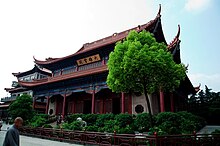Gaomin Temple
| Gaomin Temple | |
|---|---|
 Gaomin Temple | |
| Religion | |
| Affiliation | Buddhist |
| Province | Jiangsu |
| Location | |
| Location | Hanjiang District |
| Municipality | Yangzhou |
| Geographic coordinates | 32°19′36″N 119°24′46″E / 32.32667°N 119.41278°E |
| Architecture | |
| Completed | 20th century |
Gaomin Temple (Chinese: 高旻寺) is a Buddhist Temple in Hanjiang District of Yangzhou, Jiangsu Province of China. During the Qing Dynasty, it was considered one of the eight great temples of Yangzhou.
The temple is situated in a semi-rural setting about 7 km south of downtown Yangzhou, on the western shore of the Old Channel[1] of the Grand Canal of China, just south of its junction with the Yizheng-Yangzhou Canal.
History
GaoMin temple was first built in Sui Dynasty, and achieve its highest achievement in Qing Dynasty, when it was expanded two times and became huge.[2] Eight years after Shunzhi was enthroned (1651), Tianzhong Tower was built and a temple was also built next to Tianzhong Tower, called the Tower Temple. During Emperor Kangxi’s stay in the temple in his fourth southern tour, he stepped on Zhongtian Tower, overlooking the scenery, which was very beautiful and vast. Then named the temple for Gaomin Temple. Forty-two years after Kangxi was enthroned (1703), Towerbaypalace (Chinese name: 塔湾行宫) was built in west of Gaomin Temple. On Kangxi’s fifth southern tour, his palace’s area was much bigger than Gaomin Temple, and they were separated by high walls. At that time, Gaomin Temple, Zhenjiang’s Jinshan Temple, Chengdu’s Geyuan Temple and Xindu’s Baoguang Temple were known as the greatest four Zen temples.
During Kangxi years, there were five halls in it to worship Buddha, and pavilions(Chinese:碑御亭) on the left and right. Behind it, there was Gold Buddha hall, behind which Zhongtian Tower standed. Unluckily, they were all destroyed in the years of Daoguang ang Xianfeng. Then in the years of Tongzhi and Guangxu, they were rebuilt, with an installation of two- layer Yushu Building.[3]
During Monk Laiguo’s chairing the temple, he got rid of the old disadvantages and regressed to the old system, which made a great achievement. The pagodas, halls, Zen rooms, Yanshou Tang were rebuilt, that made Gaomin Temple take shape. After 1949, GaoMin was used and managed by buddhists. However, during the Cultrual Revolution, it was occupied by the Red Guard. They dismantled the halls and fixed other buildings, seting the temple on the verge of waste.
After the Third Plenary Session of the Eleventh Central Committee, the policy of religious freedom was implemented. In 1983, Gaomin Temple was listed as one of the key Han national temples. After the efforts of the relevant departments, Gaomin temple was handed over to the buddhists.
In recent years, Gaomin Temple steps to rebuild temples with the foundings. With Hong Kong buddhists’ donations, Gaomin Temple’s new Zen halls held an opening ceremony in November 1989.
Layout
In Qing Dynasty Gaomin Temple and the palace’s area is bigger than now. The palace covered an area of about fourth fifths of all, while the temple occpuied only about first fifth. The palace was in centre,and Gaomin Temple was in the east of the palace, which was subordinate to the palace.
References
- ^ In Yangzhou, there are two Grand Canal channels. The Old Channel runs through the city center, while the new channel, used by modern ships, is a few kilometers to the east.
- ^ 日扬州网 (2009-11-12). "高旻寺——禅宗四大丛林之一". IFENG.
{{cite web}}: Unknown parameter|trans_title=ignored (|trans-title=suggested) (help) - ^ [http://web.archive.org/web/20120426080057/http://www.scfj.net/html/zuixinxinxi/2007/0610/99.html "释来果禅师与高�寺"] (in Chinese). 三楚佛教网. 2007. Archived from the original on 2012-04-26.
{{cite web}}: replacement character in|title=at position 8 (help)
External links
- "Gaumin Temple". Archived from the original on 2012-05-19.
